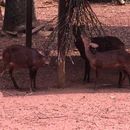Biology
provided by Arkive
A solitary animal (2), the Bawean deer is usually only seen with another deer if it is a mother and her young, a courting pair, or two rival males fighting over a female (4). When with another individual, the Bawean deer can be heard communicating with short, sharp, barks (4).
Although capable of breeding at any time of the year, Bawean deer mate primarily between July and November. After a gestation period of around seven months, the majority of young are born between February and June (4).
With a preference for grazing (2), the Bawean deer feeds chiefly on forbs and grass-like plants (4). Occasionally, it may also feed on crops (7).
Conservation
provided by Arkive
In 1979, the Bawean Island Nature Reserve was established (7), offering the mountainous habitat of the Bawean deer some much needed protection. Management activities on the island have included protecting the deer from hunting, the controlled burning of grasslands to provide deer habitat, and the thinning of teak plantations to encourage understorey development on which the deer can browse (7) (9). The removal of wild dogs has also been recommended (9). A number of Bawean deer also occur in zoos around the world (4), acting as a safeguard against this species extinction should the worst happen on Bawean Island.
Description
provided by Arkive
This rare deer, which exists on only one island, is a short-legged and bushy-tailed species (2). Its coarse hair is uniformly brown in adults, except for lighter patches on the throat and around the eyes (2) (4). Young Bawean deer, or fawns, occasionally have a few faint spots on their coat, but these disappear quickly with age (2). Like other deer, the males of this species are distinguished by their antlers: bony, hornlike growths that are typically shed and re-grown each year (5). The antlers of the Bawean deer, which are fully developed by the age of 21 months, are relatively small compared to other deer living in tropical areas (6).
Habitat
provided by Arkive
The Bawean deer inhabits hill forest (2).
Range
provided by Arkive
This small deer occurs only on Bawean Island, Indonesia, where it is most abundant in the hilly central region (7). Bawean Island, situated near Borneo, covers just 220 square kilometres (2).
Status
provided by Arkive
Classified as Critically Endangered (CR) on the IUCN Red List (1) and listed on Appendix I of CITES (3).
Threats
provided by Arkive
In the past, this diminutive deer was hunted by local people for its meat. Hunting was particularly rampant during the 1960s, when large areas of forest were cut down to plant teak, affording hunters easier access (7). Around 1977, hunting of the Bawean deer diminished, giving populations the respite they needed to recover slightly (7).
Today, hunting may remain a contributing factor to the Bawean deer's threatened status, but wild dogs (2), which prey on deer (8), as well as habitat degradation (1) (8), also jeopardise this species' continued existence. Habitat degradation takes the form of the cutting down of trees, the deliberate burning of vegetation, and the encroachment of cultivation by the human inhabitants of the island (9).

